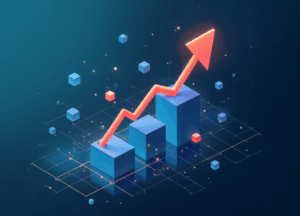Digital transformation is no longer optional. It has become a business imperative. Across industries, organizations are rethinking how they operate, how they engage customers and how they deliver value, enabled by cloud, data, AI, automation and more. But having bold digital ambitions isn’t enough.
Too often, companies get stuck at the strategy stage. They articulate a vision for a digital future but lack a concrete plan for how to get there. This results in fragmented initiatives, misaligned teams, stalled projects and underdelivered values.
That’s where a concrete, well-thought-out and scalable digital transformation roadmap comes in.
A roadmap for digital transformation is more than a schedule of projects. It is the blueprint that translates strategy into execution. It shows how to sequence initiatives, allocate resources, manage dependencies, measure progress and embed change, turning vision into sustainable transformation.
In this article, we will:
- Ground your understanding in why digital transformation matters and how it connects to competitive advantage.
- Unpack the critical components of a transformation roadmap.
- Walk step-by-step through designing and executing a roadmap for enterprise digital transformation.
- Highlight pitfalls and how to avoid them
By the end, you’ll have a clear, actionable framework to help your organization move from digital ambition to sustainable execution.
Why a Roadmap Is Critical in Digital Transformation
Digital transformation isn’t a series of disconnected projects. It’s a journey of change across systems, people and strategy. That’s precisely why a roadmap becomes indispensable: it turns ambition into a guided path.
Here’s why a digital transformation roadmap matters and what it gives you that strategy alone cannot.
Provides Clarity and Alignment Across Stakeholders
A roadmap offers a single view of how the transformation will unfold, ensuring everyone, from executives to frontline teams, can understand what’s happening when and why. As Prosci puts it, a roadmap ties business priorities to initiatives, ownership and measurable outcomes, making the path clear.
This clarity helps avoid misalignment, conflicting efforts, or redundant work.
Helps Sequence Efforts and Manage Complexity
Enterprises are complex. Legacy systems, multiple silos, interdependencies, technical debt… there is a lot happening. Without a roadmap, initiatives tend to go in parallel or ad hoc, increasing risk and friction.
A well-structured roadmap for enterprise transformation surfaces dependencies, sequences what can be done early vs. what must wait and enables you to stage changes in manageable waves.
Drives Prioritization and Resource Discipline
Your organization will always have more ideas and ambitions than bandwidth. A roadmap forces you to make hard choices: what to do now, what to defer and where to invest. It links initiatives to business value, making it easier to allocate resources where they yield the best return.
Without a roadmap, transformation can drift into being reactive rather than strategic.
Anchors Execution and Monitoring with Measurable Metrics
A good roadmap doesn’t end with planning. It embeds milestones, KPIs, feedback loops and checkpoints. Roadmaps enable real-time tracking of adoption, dependencies and progress.
These built-in metrics keep transformation honest and transparent. You know what’s going well, what’s slipping and when to recalibrate.
Enables Adaptability and Iterative Learning
Change is constant in digital transformation. Market conditions, technologies and business priorities shift and a rigid plan fails under change.
Roadmaps should be living artifacts. After every phase or pilot, you revisit assumptions, learn lessons and adjust to what comes next. You should build the roadmap for your organization ready for iteration. This adaptability helps you course-correct before minor deviations become big issues.
Bridges Strategy with Execution
Strategy defines why and what, but not how or when. A roadmap is that bridge. After clarifying objectives and current capability in enterprise transformation, you must develop a roadmap that outlines the steps needed to get from where you are… to where you want to go.
In other words, the roadmap turns strategic vision into actionable, sequenced execution.
Core Elements of a Digital Transformation Roadmap
A solid roadmap is like a blueprint. It must display all the essential elements so that the strategy becomes actionable.
Below are the critical components you should include and how they interact to guide execution.
Phases and Time Horizons
- Divide your digital transformation into phases (e.g., short-term/mid-term/long-term) or “waves.”
- Each phase should have clear objectives and outcomes.
- These horizons help manage expectations, show progress and allow learning before scaling.
- Use “stage gates” or decision points between phases to reassess, pivot, or validate assumptions.
Initiatives, Projects and Themes
- Under each phase, list the major transformation initiatives (e.g., “data platform modernization,” “process automation,” “legacy system decommission,” “customer experience redesign”).
- Group them under broader themes or capability areas to keep coherence.
- Show dependencies (which projects require others to be completed first) and critical paths.
Sequencing and Dependencies
- Not all initiatives can start simultaneously. Some depend on infrastructure build, data readiness, or pilot outcomes.
- Highlight dependencies and logical ordering.
- Sequence to deliver early value (quick wins) while enabling later, more complex work.
- Avoid “big bang” leaps. Incremental rollouts reduce risk.
Milestones, Deliverables and Timeline
- Define major milestones within each project or initiative (e.g., prototype ready, integration complete, go-live).
- Assign deliverables per milestone.
- Map them on a timeline (often a Gantt or swimlane view) so stakeholders can see what’s happening when.
- Use buffer time for unexpected delays.
Roles, Ownership and Resource Allocation
Assign ownership for initiatives (business, IT, transformation office).
- Clearly define roles and responsibilities (steering committee, program leads, change agents).
- Allocate resources (budgets, people, external vendors) aligned to projects and phases.
- To maintain alignment, include a cross-functional core team (business, tech, operations).
Metrics and KPIs (Business + Adoption)
- Define outcome metrics (e.g., revenue lift, cost reduction, customer satisfaction) tied to strategy.
- Define adoption/behavior metrics (e.g., number of users onboarded, utilization rates, process cycle times).
- For each milestone or phase, include metrics to gauge progress and trigger decisions.
- Use dashboards or scorecards to present progress.
Enablers and Supporting Capabilities
- Infrastructure and platforms (cloud, APIs, integration layers)
- Data, analytics, governance (data quality, master data, governance)
- Tools and technologies (automation, AI/ML, microservices)
- Change management and training (communication, upskilling, stakeholder engagement)
- Governance and process structures (steering committees, review cycles)
Risk Management and Mitigation
- Identify key risks (technical, organizational, external) upfront.
- For each risk, define mitigation strategies.
- Monitor risk triggers during execution.
- Build contingencies in the timeline or budget for potential friction.
Feedback Loops and Iteration
- The roadmap should not be rigid. It must incorporate feedback and learning.
- After each phase or pilot, review results, capture lessons and adjust subsequent phases.
- Use governance reviews and metrics-based decision points to recalibrate.
- This iterative adjustment ensures the roadmap remains relevant as context evolves.
Communication and Visualization
- The roadmap must be understandable by multiple stakeholders (executives, business leads and IT).
- Use visual formats: swimlanes, Gantt charts, roadmap canvases.
- Show connections between strategic goals, initiatives, phases and metrics.
- Maintain transparency — share progress, risks and changes to foster trust.
These elements together ensure that your roadmap is not a vague promise but a living guide, aligning vision, execution, people and metrics.
Step-by-Step to Create and Execute Your Digital Transformation Roadmap
A roadmap isn’t created in one go. It emerges through structured steps that convert strategic intent into executable work.
Here’s a recommended sequence, each step builds on the last, for designing, launching, monitoring and evolving your digital transformation roadmap.
Assess Existing State (Technology, Process, Culture)
- Inventory your current systems, architecture, integration layers, data maturity, technical debt and legacy constraints.
- Survey business processes and operational workflows to identify inefficiencies and duplication.
- Map cultural, organizational and skills gaps: what capabilities are missing, where resistance exists.
- Conduct stakeholder interviews and readiness assessments (for change and adoption).
- Use artifacts such as maturity models, gap analyses, SWOT, or capability maps to visualize “where you stand vs where you need to go.”
Identify Key Stakeholders and Leaders
- List all stakeholders who will be affected or whose support is needed (business units, IT, operations, compliance, leadership).
- Clarify sponsorship and accountability: who will champion, who will decide and who will own execution.
- Form a cross-functional core team (business, tech, operations, transformation office) to act as the engine of roadmapping.
- Engage early to align expectations, surface concerns and secure commitments.
Define Clear Objectives and Success Metrics
- Translate strategy into measurable outcomes, such as cost reduction, process cycle time, revenue uplift, customer satisfaction and agility indicators.
- Ensure objectives are SMART (Specific, Measurable, Achievable, Relevant, Time-bound).
- For each objective, define leading indicators (adoption, usage) and lagging indicators (business impact).
- Map these metrics to phases or initiatives in the forthcoming roadmap, so each initiative is tied to outcomes.
Build the Roadmap (Design Initiatives, Sequencing and Prioritization)
- Enumerate candidate initiatives/projects (e.g., infrastructure upgrade, API layer, process automation, data platform, modernization).
- Prioritize using impact vs. effort, dependencies, risk and strategic alignment.
- Sequence initiatives respecting dependencies (e.g., data foundation before AI use cases).
- Organize into waves or phases (short-term, medium, long-term) to deliver early value.
- For each initiative, define milestones, deliverables, timeline and ownership.
- Embed enablers (change, data, tech, governance) as cross-cutting themes in the roadmap.
Allocate Budget, Resources and Staffing
- Estimate each initiative’s costs (development, infrastructure, licensing, change, training).
- Allocate resources (internal, external partners) based on priorities.
- Ensure you have bandwidth for change management, training and communication.
- Adjust staffing and roles to support cross-functional execution (e.g., transformation office, change agents).
Prepare and Equip People to Adopt Change
- Integrate change management deeply (not as an afterthought).
- Use Prosci’s 3-Phase Process and ADKAR model to guide individual and organizational transitions.
- Phase 1 (Prepare): define success, impact and approach. Build sponsorship.
- Phase 2 (Manage): design communication, training and coaching plans. Monitor progress.
- Phase 3 (Sustain): Reinforce behaviors, hand over operations and embed the change.
- Conduct role-based training, workshops, pilot groups and coaching for early adopters.
- Communicate regularly. Explain why changes are happening and what’s in it for each stakeholder.
- Monitor resistance signals and feedback; address barriers proactively.
Implement Initiatives and Integrate Technology
- Execute projects in waves. Start with pilots or low-risk workstreams to validate assumptions.
- Monitor dependencies and manage integration challenges.
- Use agile or iterative delivery where possible to adapt and course-correct.
- Ensure that technical deployments align with business and change expectations (i.e., adoption is baked in).
Monitor, Evaluate and Adjust
- Track the roadmap’s progress using your KPI framework.
- Use dashboards or scorecards to show performance versus plan.
- Hold governance reviews/stage gates to decide whether to proceed, pivot, pause, or re-prioritize.
- After each phase or pilot, capture lessons learned and refine the roadmap accordingly (feedback loops).
- Maintain agility. Context, markets and technology may shift. Eventually, the roadmap must evolve.
Sustain and Embed Change
- Transfer ownership of successful changes into core business operations.
- Continue communication and reinforcement (celebrate wins and reinforce behaviors).
- Monitor post-rollout performance to detect slippage or deviation from expected benefits.
- Use structures such as governance bodies or transformation offices to prevent regression.
- Regularly revisit the roadmap. Digital transformation is a journey, not a destination.
Iterate and Scale
- Once early success is validated, scale further into more complex workstreams or domains.
- Use momentum to build stakeholder confidence and open up resources for subsequent phases.
- Repeat the cycle: assess -> re-prioritize -> design -> execute.
- Continuously sharpen measurement, feedback and adaptability so transformation remains aligned and responsive.
This step-by-step guide helps make the roadmap real and achievable.
How to Weave Change and People into the Roadmap (Change Management and ADKAR)
Even the best technical roadmap will stall if people don’t follow it. Change management must not be an afterthought; it should be embedded in the roadmap from the start.
Below is a practical guide to integrating the people’s side of transformation using the Prosci approach.
Change Management Principles and Frameworks
Prosci’s change management methodology is widely used in digital transformation because it scales individual change to organizational change. Its key components include:
- PCT (Prosci Change Triangle) — balancing Leadership/Sponsorship, Change Management, Project Management and Defined Success.
- ADKAR Model — Awareness, Desire, Knowledge, Ability, Reinforcement. It is a model focusing on individual change steps.
- 3-Phase Process — Prepare Approach → Manage Change → Sustain Outcomes.
In digital transformations, people must navigate not just new tools but new ways of working, new processes, shifts in roles and cultural mindsets.
Prosci data suggests that initiatives with strong change management are much more likely to succeed (meet objectives) than those without.
Integrating ADKAR into the Roadmap
ADKAR (Awareness of the need for change, Desire to participate, Knowledge of how to change, Ability to implement changes and Reinforcement to sustain), developed by Jeff Hiatt of Prosci, can be considered the “people pathway” that runs parallel with your technical/programmatic pathway in the roadmap. As you plan phases, initiatives and milestones, you must overlay change activities mapped to ADKAR.
| ADKAR Phase | What It Means in Practice | Activities to Include |
| Awareness | Individuals understand why change is needed | Leadership messaging, internal communication campaigns, town halls, visuals showing “future state vs status quo” |
| Desire | Individuals choose to support the change | Workshops, insight sessions, involvement in planning, clarifying personal benefits, addressing “what’s in it for me” |
| Knowledge | Individuals know how to change | Role-based training, coaching, guides, job aids, simulations, sandbox environments |
| Ability | Individuals can execute new ways of working | On-the-job coaching, practice sessions, peer mentors, troubleshooting support |
| Reinforcement | Change sticks; behaviors become standard | Recognition, feedback loops, incentives, continuous reminders, embedding in performance metrics |
Sponsorship, Role of Leaders and Change Agents
- Active and visible executive sponsorship is critical. Leaders must not just endorse the transformation, but live it, communicate it and remove barriers.
- Create a network of change agents/champions across business units/teams to localize messaging, surface issues and act as early adopters.
- Align managers to cascade change, equip them to coach their teams, block resistance and reinforce behaviors.
- Integrate change responsibilities into roles; make them part of accountabilities (not extra work).
Preventing and Managing Resistance
- Resistance is natural and expected. Plan for it proactively.
- Use diagnostic tools (ADKAR assessments, feedback and pulse surveys) to spot barriers early.
- Tailor interventions: For someone stuck at Desire, focus on conversations, involvement and clarity; for someone stuck at Ability, add coaching and support.
- Use communication and transparency to reduce fear, uncertainty and rumors.
- Recognize wins early and publicly to signal momentum.
Embedding Change and Ensuring Sustainability
- Don’t drop change support after the go-live or phase completion. Reinforce the new working methods.
- Include reinforcement mechanisms: performance metrics, process audits, feedback, refresher training.
- Transition change ownership into operations/business units so the transformation becomes part of business-as-usual.
- Use lessons learned to refine future phases (feedback loops).
- Periodically revisit the enterprise digital transformation roadmap and change assumptions based on real adoption and behavior data.
Why NetEffect Is Your Ideal Transformation Partner
In a world where digital transformation is central to competitive advantage, success requires more than vision. It demands an execution partner who understands technology, change and business together.
At NetEffect:
- We deliver full-stack digital transformation services, from strategy and program management to engineering, IT operations and managed services, ensuring your roadmap doesn’t just sit on paper but becomes reality.
- As a trusted partner in Adobe Experience Cloud, we provide consulting, migration, development and ongoing support across AEM, Analytics, Target, Launch and more.
- Our deep Adobe expertise sets us apart: we have a dedicated team of architects and developers capable of delivering large-scale Adobe cloud services, including implementation, tuning performance, managing upgrades and driving adoption.
- Because NetEffect is an Adobe partner, you benefit from direct alignment with Adobe’s ecosystem, best practices and access to in-depth technical insight, which helps reduce risk and accelerate your transformation path.
If your organization is ready to turn its digital ambition into sustained impact, especially via Adobe, NetEffect is here to guide and execute the journey with you.







